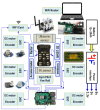A Dynamic Motion Analysis of a Six-Wheel Ground Vehicle for Emergency Intervention Actions
- PMID: 33669001
- PMCID: PMC7956183
- DOI: 10.3390/s21051618
A Dynamic Motion Analysis of a Six-Wheel Ground Vehicle for Emergency Intervention Actions
Abstract
To protect the personnel of the intervention units operating in high-risk areas, it is necessary to introduce (autonomous/semi-autonomous) robotic intervention systems. Previous studies have shown that robotic intervention systems should be as versatile as possible. Here, we focused on the idea of a robotic system composed of two vectors: a carrier vector and an operational vector. The proposed system particularly relates to the carrier vector. A simple analytical model was developed to enable the entire robotic assembly to be autonomous. To validate the analytical-numerical model regarding the kinematics and dynamics of the carrier vector, two of the following applications are presented: intervention for extinguishing a fire and performing measurements for monitoring gamma radiation in a public enclosure. The results show that the chosen carrier vector solution, i.e., the ground vehicle with six-wheel drive, satisfies the requirements related to the mobility of the robotic intervention system. In addition, the conclusions present the elements of the kinematics and dynamics of the robot.
Keywords: dynamic; kinematic; mobile robotics; mobility; rescue; sensors; wheel.
Conflict of interest statement
The authors declare no conflict of interest.
Figures


























References
-
- Hoeppe P. Trends in weather related disasters—Consequences for insurers and society. Weather Clim. Extrem. 2016;11:70–79. doi: 10.1016/j.wace.2015.10.002. - DOI
-
- Fire and Rescue Authorities Operational Guidance Generic Risk Assessment 3.10 Fighting Fires in Petrochemical Plant and Pipelines. [(accessed on 24 February 2021)]; Available online: https://assets.publishing.service.gov.uk/government/uploads/system/uploa....
-
- Nuță I. Ph.D. Thesis. Military Technical Academy “FERDINAND I”; Bucharest, Romania: 2013. Contributions to the Development and Improvement of Emergency Intervention Techniques; p. 352.
-
- Virginia Tech Takes on Department of Defense Challenge to Build Disaster-Response Robots. [(accessed on 24 February 2021)]; Available online: https://vtnews.vt.edu/articles/2012/10/102412-engineering-thorrobotannou...
LinkOut - more resources
Full Text Sources
Other Literature Sources

